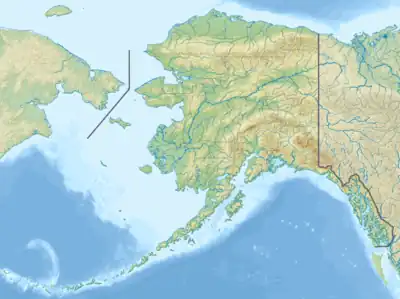| Mount Abbe | |
|---|---|
 Mount Abbe, north aspect | |
| Highest point | |
| Elevation | 8,200 ft (2,500 m)[1] |
| Prominence | 938 ft (286 m)[1] |
| Coordinates | 58°47′52″N 137°04′41″W / 58.79778°N 137.07806°W[1] |
| Geography | |
 Mount Abbe Location of Mount Abbe in Alaska | |
| Location | Glacier Bay National Park and Preserve Hoonah-Angoon Alaska, United States |
| Parent range | Fairweather Range Saint Elias Mountains[1] |
| Topo map | USGS Mount Fairweather D-4 |
| Geology | |
| Type of rock | Granite[2] |
| Climbing | |
| First ascent | June 11, 1977 |
| Easiest route | Mountaineering |
Mount Abbe is an 8200+ feet (2499+ meter) double summit mountain located in the Fairweather Range of the Saint Elias Mountains, in southeast Alaska.[3] The peak is situated near the terminus of the Johns Hopkins Glacier, within Glacier Bay National Park and Preserve, 100 mi (161 km) northwest of Juneau, and 8.2 mi (13 km) northeast of Mount Orville. Although modest in elevation, relief is significant since the mountain rises up from tidewater in less than two miles. Mount Abbe is often seen and photographed with the Johns Hopkins Glacier, which is a popular destination for cruise ships. The mountain was named in 1936 by William Osgood Field and William Skinner Cooper, of the American Geographical Society, for Cleveland Abbe Jr., (1872-1934), an American geographer.[3] Abbe received a Ph.D. in 1898 from Johns Hopkins University. The Gilman Glacier and Clark Glacier on the mountain's slopes were named for Daniel Coit Gilman, the institution's first president, and William Bullock Clark who was a professor of geology at the university. The mountain's name was officially adopted in 1937 by the United States Geological Survey.[3] The first ascent of the south summit was made June 11, 1977, by Jim Wickwire and Dusan Jagersky via the Southeast Face.[1] Three days later, Dusan Jagersky was killed while descending an unnamed peak.[4] The first ascent of the north summit was made July 14, 1991, by Walter Gove and William Pilling.[5] The months May through June offer the most favorable weather for climbing Mount Abbe, but it's a challenging climb in any conditions, with few attempts.
Climate
Based on the Köppen climate classification, Mount Abbe has a subarctic climate with cold, snowy winters, and mild summers.[6] Temperatures can drop below −20 °C with wind chill factors below −30 °C. This climate supports the Clark, Johns Hopkins, and Gilman Glaciers on its slopes. Precipitation runoff and meltwater from its hanging glaciers drains into Johns Hopkins Inlet.
See also
References
- 1 2 3 4 5 "Mount Abbe, Alaska". Peakbagger.com. Retrieved January 17, 2020.
- ↑ "Climbing in Mount Abbe, Wrangell, St. Elias, University and Fairweather Ranges". Mountain Project.
- 1 2 3 "Mount Abbe". Geographic Names Information System. United States Geological Survey, United States Department of the Interior. Retrieved January 17, 2020.
- ↑ Wickwire, James (1978). "AAC Publications - Dusan Jagersky, 1940-1977". americanalpineclub.org. The American Alpine Club. Retrieved August 1, 2023.
- ↑ "Mount Abbe - Glacier Bay National Park & Preserve". www.nps.gov. U.S. National Park Service.
- ↑ Peel, M. C.; Finlayson, B. L.; McMahon, T. A. (2007). "Updated world map of the Köppen−Geiger climate classification". Hydrol. Earth Syst. Sci. 11 (5): 1633. Bibcode:2007HESS...11.1633P. doi:10.5194/hess-11-1633-2007. ISSN 1027-5606.
Gallery
 Mount Abbe with Johns Hopkins Glacier
Mount Abbe with Johns Hopkins Glacier A glimpse of its two summits
A glimpse of its two summits
External links
- Weather forecast: Mount Abbe
- National Park Service: Mount Abbe
- Account of first ascent of north summit: Americanalpineclub.org
- Summit detail: Flickr photo
- Flickr: video